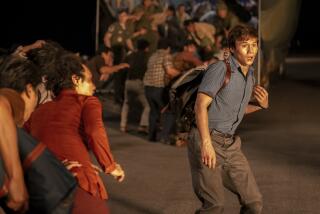Hollywood Image of Military Is Wrong
With the nightly TV news once again dominated by pictures of our troops deployed in a potentially hostile environment, would it be asking too much for the movies to accurately portray the American military?
I don’t think so. Yet, all too frequently filmmakers make a number of basic mistakes when Hollywood goes to war.
A recent example: the HBO movie “The Enemy Within,” a story about a military plot to take over the government. (“ ‘Enemy Within’ a ‘90s ‘Seven Days in May,’ ” Calendar, Aug. 20).
For one thing, while it makes a terrific visual in the film, someone needs to let Hollywood in on the secret that troops deploying for battle do not march in neat formations. That went out of fashion sometime around Gettysburg.
The sight of military vehicles rolling down suburban streets is another powerful image the film offers--I well remember the sick feeling I had seeing my own troops on the road during the Los Angeles riots. However, sponsors of a potential coup probably would be more interested in securing main freeway intersections, telephone switching centers, airports, power stations and City Hall. HBO’s coup appeared to be aimed at the Hollywood Hills. While some in Hollywood may not believe it, not even the most left-wing movie stars’ and producers’ homes would make the target list.
The choice of actors portraying soldiers was another problem. Jason Robards has the aura of a four-star general but he could have used a haircut. Forrest Whittaker is not only the youngest full-bird colonel in military history but, to be diplomatic, perhaps the largest Marine on active duty. Of course, sometimes Hollywood does get it right. Gary Sinese in “Forrest Gump” simply is a lieutenant, and, I must admit, Pauly Shore of “In the Army Now” does bear a startling resemblance to one of my former troops.
Another pet peeve of mine has always been movie uniforms. Happily, some costume designer mastered the arcane art of determining the proper precedence of the characters’ ribbons. Still, one never sees an officer strolling about with his coat open and tie loose. One wears the uniform correctly, or not at all, even when being chased by assassins.
Of course, these are merely superficial errors, but the substance of the film is where the filmmakers truly failed. Rod Serling, scriptwriter of the film “Seven Days in May,” on which this version was based, was an ex-paratrooper and was at least familiar with the military subculture. Nothing of the sort was evident here.
The generals and admirals of “The Enemy Within” are a Central Casting collection of right-wing nuts parading around in medal-encrusted uniforms spouting neo-fascist cliches. Nothing could be further from the truth. In fact, the model officer of today is recently retired Gen. Norman Schwarzkopf. Not only is he tactically proficient, but he is a true scholar as well. In that spirit, advancement beyond major today requires that an officer earn an advanced post-graduate degree.
Still more irritating is the view of the grunts themselves. None but the heroic Whittaker utters so much as a peep when ordered to topple the elected President of the United States. Does Hollywood really have so little faith in the loyalty of those who defend their country?
The portrayal of servicemen and women as mindless robots does a great disservice. Even though the Cold War is over, under President Clinton Americans have been under fire in the Persian Gulf, Bosnia and Somalia. Troops are at risk in Haiti while the nation faces possible conflict with Iraq and perhaps even North Korea.
By dehumanizing these men and women, Hollywood makes sending them off to war that much easier. By showing soldiers as the real people they are, Hollywood could be sending a far more important and meaningful message.
More to Read
Only good movies
Get the Indie Focus newsletter, Mark Olsen's weekly guide to the world of cinema.
You may occasionally receive promotional content from the Los Angeles Times.










